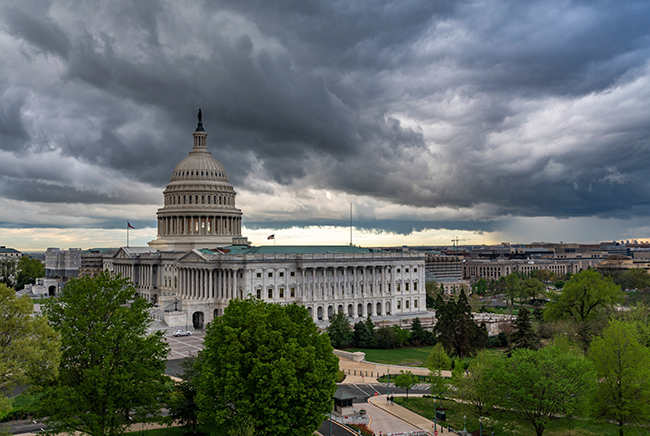
Lawmakers are trying to compromise on a fiscal 2020 defense policy bill as a new, slimmed-down version offers a fallback option. Architect of the Capitol photo via Twitter.
A slimmed-down version of the fiscal 2020 defense policy bill recently introduced by Sen. Jim Inhofe (R-Okla.), while lacking major parts of the original legislation, would allow the Pentagon to keep F-35 purchases on track and for certain Air Force construction projects to proceed.
The “skinny” draft National Defense Authorization Act, made public Oct. 29, allows the Defense Department to award multiyear contracts to buy Lockheed Martin’s F-35 Joint Strike Fighter from fiscal 2021 to 2023, or Lots 15-17.
USAF plans to buy 48 F-35As a year in that timeframe, according to its 2020 budget request. Those figures could grow via the service’s additional funding wish list or if the acquisition plan changes.
For military construction, the bill green-lights land acquisition, planning, design, and construction for new family housing units, and allows for military housing improvements.
It provides authorities to build a slew of intelligence analytics, fusion, exploitation, and training facilities at RAF Molesworth, England, as well as a dorm for F-35 personnel at RAF Lakenheath in the country.
JB San Antonio, Texas, could move ahead with a dining and classroom facility and an air traffic control tower; Hanscom AFB, Mass., could make progress on a 1,000-kW generator at a laboratory.
The service may also do work at installations in Iceland, Spain, Norway, and other undisclosed locations around the world, according to the bill. It does not explicitly describe funds to revitalize Tyndall AFB, Fla., or Offutt AFB, Neb., respectively hit by a Category 5 hurricane and widespread flooding.
Inhofe’s legislation calls for a report on how the military services will implement the recommendations of the National Commission on Military Aviation Safety as well.
The draft would allow troops and civilians to get paid, and allow for child care and other services for military families. It would also extend the authorities that combat troops need to fight the Islamic State group, al-Qaida, and the Taliban, among other provisions. The bill does not mention a Space Force, nuclear modernization, the F-15EX, or many other Air Force priorities in the current fiscal year.
The Senate Armed Services Committee chairman introduced the bill as a backup option in case lawmakers in each chamber and across party lines can’t come to an agreement on the larger annual defense policy bill. Lawmakers are still working on that compromise, and some argue the new bill would set back months of negotiations.
Rep. Don Bacon (R-Neb.) said on Twitter that passing the skinny NDAA this year “would be a defeat for US national security.” Rep. Ro Khanna (D-Calif.) also tweeted that he opposes an NDAA that “fails to include my amendments ending the war in Yemen and blocking war with Iran.”
If the stripped-down legislation moves forward, it will likely hit strong opposition in the Democratic-controlled House because it allows DOD to shift funding from military projects to build a wall along the southern US border championed by President Donald Trump.
“A skinny NDAA isn’t necessary and may be counterproductive,” Todd Harrison, a defense budget expert at the Center for Strategic and International Studies, wrote for Defense One. “Congress should instead focus its energy on finishing the full authorization bill in a timely manner. If Congress decides to pass a skinny NDAA, then it should include all the items that have already been successfully negotiated in conference committee and punt the remaining issues to the appropriations bill.”
Further details about how the services could spend their money will become available if the bill goes to the Senate floor for consideration, a Senate Armed Services Committee spokeswoman said.